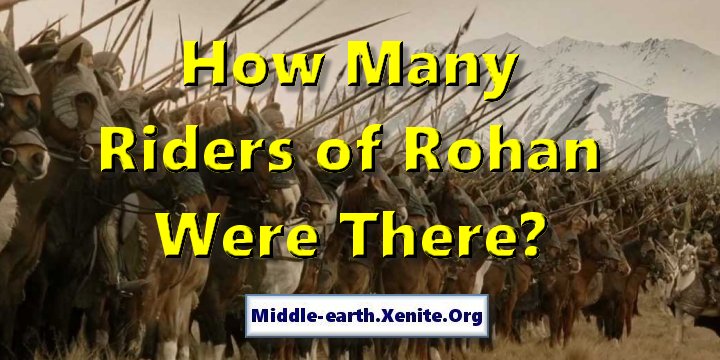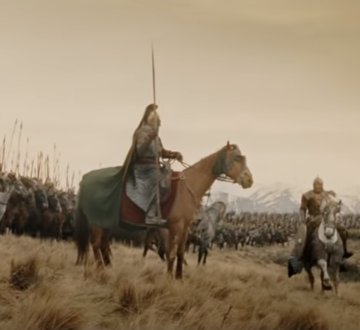
Q: How Many Riders of Rohan Were There?
ANSWER: This is one of those questions that requires some temporal qualification. That is, there were fewer Riders in Eorl’s host in Third Age year 2510 than Theoden could have assembled in a full muster in 3018/9.

There is (so far as I know) only 1 book that serves as a source of authoritative information from J.R.R. Tolkien about the numbers of the Riders, and that is Unfinished Tales of Numenor and Middle-earth. As I have noted before, it is impossible to define a singular Tolkien canon so some people may not accept Unfinished Tales as an authoritative source of information. Still, the materials concerning the Northmen and the Rohirrim strike me as being rather finished and well-integrated into the “facts” established by The Lord of the Rings.
In my 2002 essay “Middle-earth Revised, Again” I wrote:
It is much to suppose that J.R.R. Tolkien intended to create, at the end of his life, a companion volume to The Lord of the Rings. And yet, one easily gets the impression that is what he was working toward, with or without clear intention. The works Christopher associates with this project were “Cirion and Eorl”, “The Disaster of the Gladden Fields”, the essay on the Druedain (only part of which was published in Unfinished Tales), “and the philological essays excerpted in ‘The History of Galadriel and Celeborn'”.
Unfinished Tales is not Christopher Tolkien’s approximation of what that companion volume might have been (as The Silmarillion was for its sources) but it seems to include a great deal of the material that would have been included in such a book, had J.R.R. Tolkien been able to bring his work to full completion.
People often complain that I just make up stuff about Middle-earth — that I mix my speculations with the facts. While that has never been true, it is true that I generally tend to limit the citations I include in my longer articles; and I rarely provided any precise source citations in the essays I wrote for Suite 101 more than 10 years ago (which I have been gradually republishing in the Tolkien Essay Archive here on Xenite.Org). The majority of people can be forgiven for doubting my word on topics such as the numbers of the Riders of Rohan, but frankly some of my critics have misled people. They knew perfectly well where I got the information because had discussed the passage innumerable times on the Usenet.
The source for the numbers of the Riders of Rohan (and for the makeup of the Muster of Rohan) is Note 36 for the story “Cirion and Eorl”, published in Unfinished Tales. This book, as I understand it, sold more than a million copies — and in fact has been pirated on the Internet more than once. And I am sure I have quoted the full passage in numerous email and news group discussions. I provide the passage as best I can here for your convenient reference.
36 According to a note on the ordering of the Rohirrim, the éored “had no precisely fixed number, but in Rohan it was only applied to Riders, fully trained for war: men serving for a term, or in some cases permanently, in the King’s Host. Any considerable body of such men, riding as a unit in exercise or on service, was called an éored. But after the recovery of the Rohirrim and the reorganization of their forces in the days of King Folcwine, a hundred years before the War of the Ring, a ‘full éored’ in battle order was reck-oned to contain not less than 120 men (including the Captain), and to be one hundredth part of the Full Muster of the Riders of the Mark, not including those of the King’s Household. [The éored with which Éomer pursued the Orcs, The Two Towers III 2, had 120 Riders: Legolas counted 105 when they were far away, and Éomer said that fifteen men had been lost in battle with the Orcs.] No such host, of course, had ever ridden all together to war beyond the Mark; but Théoden’s claim that he might, in this great peril, have led out an expedition of ten thousand Riders (The Return of the King V 3) was no doubt justified. The Rohirrim had increased since the days of Folcwine, and before the attacks of Saruman a Full Muster would probably have produced many more than twelve thousand Riders, so that Rohan would not have been denuded en¬tirely of trained defenders. In the event, owing to losses in the western war, the hastiness of the Muster, and the threat from North and East, Théoden only led out a host of some six thousand spears, though this was still the greatest riding of the Rohirrim that was recorded since the coming of Eorl.”
The full muster of the cavalry was called éoherë (see note 49). These words, and also Éothéod, are of course Anglo-Saxon in form, since the true language of Rohan is everywhere thus trans¬lated (see note 6 above): they contain as their first element eoh “horse.” Éored, éorod is a recorded Anglo-Saxon word, its second element derived from rád “riding;” in éoherë the second element is herë “host, army.” Éothéod has théod “people” or “land,” and is used both of the Riders themselves and of their country. (Anglo-Saxon eorl in the name Eorl the Young is a wholly unrelated word.)
The full section provides enough detail for us to collate a simple history of the Muster of Rohan (or the Riders). From the primary narrative itself we can extract the following:
At last the whole host was assembled; and only a few hundreds were left behind to support the men unfitted for such desperate venture by youth or age. It was then the sixth day of the month of Víressë. On that day in silence the great éohere set out, leaving fear behind, and taking with them small hope; for they knew not what lay before them, either on the road or at its end. It is said that Eorl led forth some seven thousand fully-armed riders and some hundreds of horsed archers….
I would guess by these numbers that Eorl commanded about 8,000 arms-capable men. That’s a respectable force. King Folcwine (reigned Third Age year 2830-2903) sent his twin sons Fastred and Folcred to aid Gondor in 2885. We don’t know exactly how many Riders Folcwine sent to Gondor but according to Note 36 he had a full muster of 12,000 Riders and he sent fewer than 6,000 to help Gondor. Theoden’s full muster was limited to 12,000 Riders but he could have raised even more men than that.
So why did Theoden lead only 6,000 Riders to Gondor? First, because he had to cut short the Muster. Gondor’s need was too great for Theoden to wait on everyone to arrive at Dunharrow. The Rohirrim lived in villages scattered throughout the Ered Nimrais and it took time for word to reach them as well for the men to assemble in companies (presumably) and then ride to Dunharrow. And Gandalf had counselled Theoden to hide the numbers of his men so they were taking mountain paths.
But as the texts mention Theoden had to leave men behind to defend Rohan (although the Ents provided assistance in defeating Sauron’s forces). And, also, the Riders had already suffered some losses in their battles with Saruman’s forces. So Theoden probably did not have a full 12,000 Riders for his Muster although — had he been given time — he could have easily replaced his losses.
The Muster of Rohan was neither a medieval army nor a modern one. It is a fantasy military organization that adopts a number of historical practices used in different places and periods. It fits the needs that Tolkien (who had formal military training) deemed were relevant to the geography and political situation of Rohan at the time of the War of the Ring. According to the narrative for “The Battles of the Fords of Isen” not all of Rohan’s warriors were Riders. There were apparently supplemental companies of infantry attached to the Muster and there were local levies as well.
The 1,000 men whom Theoden led to the Hornburg undoubtedly included his “household knights” but we don’t know if the rest were simply a local levy, a selection of Riders, or a combination of both. What we can be sure of is that Rohan was able to field an army of more than 12,000 fighting men by the start of the War of the Ring. There are one or two references to men who were former Riders (such as Erkenbrand) who were “called up” to serve in the War of the Ring.
There is no real need to speculate on the numbers unless you just like to see complete, exact, precise numbers for marching hosts. In which case, feel free to use the information provided by J.R.R. Tolkien as a guideline. If I have not answered all the questions that people have raised about my numbers and essays through the years, then please feel free to leave a comment. I do eventually see questions posted in various forums but it could be years before I see a follow up. At the very least, I hope people will do me the courtesy of asking where I get my information before just blindly claiming that I make it all up. That’s completely unnecessary and more often than not just plain wrong.
See also…
How Many Noldor Left the Undying Lands in Fëanor’s Rebellion?
How Many Elves Lived in Rivendell?
Elves by the Numbers (Classic Essay)
How Many Rangers of the North Were There?
How Many Men Entered Beleriand?
How Many Elves Lived in Middle-earth?
How Many Soldiers Fought in the Battle of Five Armies?
# # #
Have you read our other Tolkien and Middle-earth Questions and Answers articles?
